Being an effective supervising driver
For parents, this period may be a challenging experience especially if they have not had any experience teaching learner drivers. Many supervising drivers get anxious about their role and it can be quite stressful sitting as a passenger in your own car with a beginner driver in control. A bit of stress is perfectly normal. It can help you stay alert and aware of what's going on in and around the car. Too much stress during your driving sessions is not good. You can reduce the stress levels and help make the experience positive.
Being a supervising driver is like being a sports coach.
Your job is to give your learner opportunities to practise driving under your supervision.
You'll work together to plan driving practice sessions so
your learner develops safe driving skills in different driving situations. You will gradually increase the level of difficulty when your learner is ready.
You're not an instructor, but you will have to give lots of advice, early in the learner period. You should engage with a professional driving instructor at any time, whenever you or your learner need some extra assistance.
At the end of the learner period, you can be satisfied that you've made a significant difference to the safety of your learner driver.
Learning to drive involves a partnership between your learner, a professional driving instructor and yourself. Most learners have professional driving lessons, which can add 3 hours for every 1 lesson hour in the QLD Log Book (up to 30 hours), and rely on their supervising driver for most of their practice. The opportunity is there for you to plan practice sessions with your learner and communicate with your driving instructor for extra guidance. Our instructors don't mind if you sit in the back seat on one or two professional driving lessons to appreciate the requirements of skilling a new driver.
At Rightway Driving School we are committed for our customers to be "Safe Drivers, For Life" which means that our focus is not on passing the driving test, but rather on ensuring the learners are safe drivers at the time they obtain their licence. This focus is for good reason, as new drivers have a much higher risk of crashing than more experienced ones.
After 12 months of driving, new drivers almost halve their initial crash rate and their safety continues to improve for several years after licensing. As you will see in the below chart learner drivers are the safest drivers, for reasons such as being supervised and also driving in a controlled environment, whereas new platers represent the highest crash risk. This is the challenge of going from being a learner to being a solo driver.
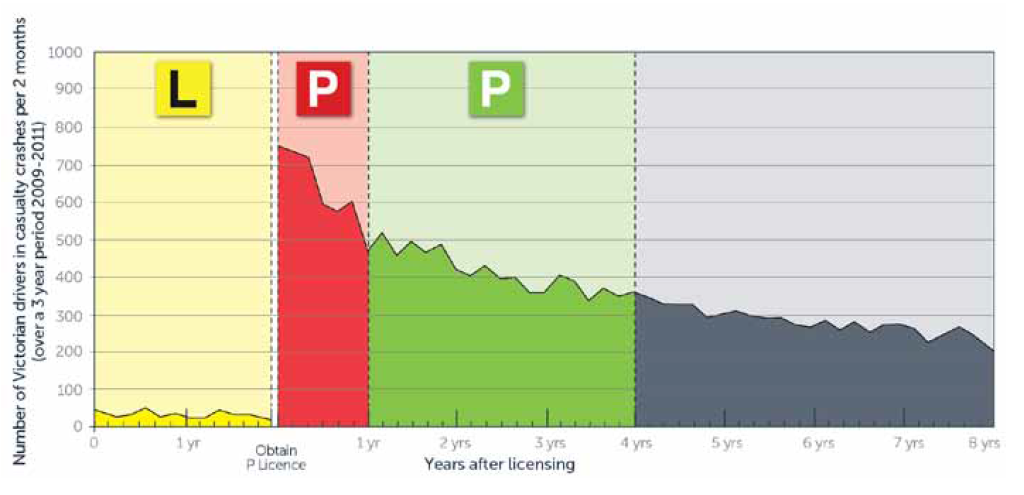
Look at dividing the learner period into four stages to get the best progress and outcomes.
- Stage 1 is about controlling the car.It's the shortest stage and aims to your learner to start, stop and steer safely in quiet areas without traffic. We recommend to our customers to start driving lessons as early as possible after getting the learners licence and to take 3 to 5 driving lessons with one of our professional, calm and systematic instructors before commencing driving with parents.
- Stage 2 is about applying new car control skillsand looking out for other road users on quiet low speed roads with little traffic. Progressive skills development ensures that the learner gets the right habits and they become second nature.
- Stage 3takes longer and uses the Stage 1 and Stage 2 skills on busier roads and in more difficult driving situations. Now the learner starts becoming a real driver. They learn to deal with traffic and other hazards to become safer in varied driving situations. These advanced skills are best supported by regular professional instruction with plenty of quality practice with parents.
- Stage 4takes a long time and can be the longest stage. It involves the learnerpractising to be a solo driver. They still have L plates on the car and a supervising driver beside them, but they'll learn to make most of the driving decisions on their own. The aim is to build up lots of different experiences where they act like a solo driver.
The SA Government video explains the need for varied and frequent practice.
It is all about blending professional driving lessons with quality driving practice with parents supported by strong communication with your driving instructor.
Rightway Driving School offers the Federal Government funded Keys2Drive lesson which brings together parents, learner and the instructor for a mix of both theory (discussion) and practical sessions during the hour long lesson. The accredited instructor will identify and discuss the key challenges of becoming a solo driver and then deliver a practical session based on the specific needs identified during discussions. This practical may include a commentary drive, a specific manoeuvre such as reverse parallel parking or speed control. Keys2Drive helps get parents and learners communicating and on the same page for setting goals for the learner period. More information is available here .
Practice to avoid crashes
Crashes are rarely just bad luck. Four common crashes involving probationary licence drivers include:
• running into the back of another vehicle
• turning right at intersections
• being hit by a right turning vehicle
• single vehicle crashes.
Each of these crashes are represented below with tips on how to avoid them. These are points to remember for practice drives.
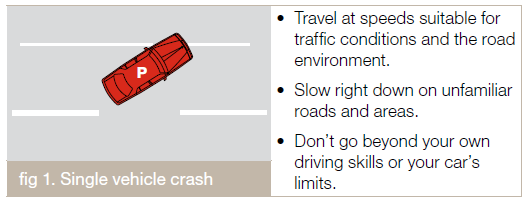
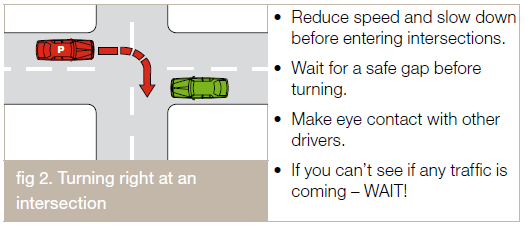
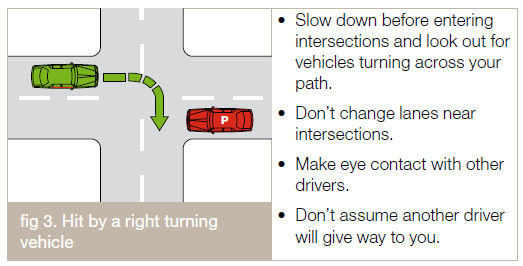
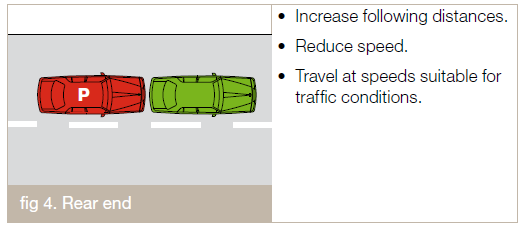
To avoid the four common crash types, learners require lots of experience and practice in these key safe driving behaviours:
• leaving a safe space and following distance from
other vehicles
• good speed control, adjusted to match traffic conditions and the road environment
• choosing a safe gap in traffic when turning and merging.
Interstate Driving
If you are planning to travel interstate these holidays, then there will be further opportunity to practice. A learner from the QLD can continue to learn to drive in NSW. When driving in New South Wales, interstate and overseas learner drivers must comply with the following licence conditions:
-
Be supervised at all times by the holder of a full Australian driver licence that is a class C or higher
- Have L plates displayed conspicuously at the front and rear exterior of the car (or an L sign on the roof) when driving
- The letter 'L' on the plate must not be hidden
- Not tow any other vehicle
- Not exceed zero blood alcohol concentration (this means you cannot drink before driving). It is also illegal to drive under the influence of drugs
- Not supervise another learner driver.
- Only carry the number of passengers that can be properly seated in seats and restrained by approved seat belts or child restraints
- Only drive vehicles that have a seat belt fitted to the driver's position and you must wear the seat belt
- Not use any functions of a mobile phone including hands-free devices.
A QLD learner must also comply with any other conditions applied to your licence, by your licensing authority.
An QLD learner, when driving in NSW, must not drive/ride faster than the posted speed limit, whereas a NSW learner has speed limits which often are less than the posted speed limit.
You need to keep the following in mind while driving with your learner this holiday:
- Learning to drive is hard. It seems easy once you've done it for a few years, but it can be a challenge for learners, even those with good coordination skills.
- Have realistic expectations because your learner will make mistakes. Sometimes they'll have trouble applying their new skills to challenging situations.
- Let your learner know (often) that you expect it will take lots of practice to become a safer driver.
- Keep reinforcing the message that developing skills takes lots of time and practice. It helps to keep overconfidence under control.
- Work with your learner. When you're planning practice sessions and driving routes early on, get them involved. Check that they're happy with each session and ask their suggestions about what to include.
- Don't be afraid to take over driving if the conditions change. If your learner doesn't have much experience in the rain and you drive into a storm, take over so you both stay safe. Your learner shouldn't drive beyond their ability.
- You will have to give critical feedback sometimes. If it's important, do this while driving, but sometimes
it's better to suggest parking somewhere safe to talk. This way you can provide feedback without interfering with your learner's concentration.
Giving the Gift of Safe Driving
Do you invest in a safer driving future for your child or give other gifts that are consumed without enduring value? Our Xmas Gift Vouchers provide a range of affordable options for every family with a learner. They are also a great gift idea for caring grandparents. Check out our range of xmas gift vouchers .
References:
http://mylicence.sa.gov.au/parents-and-supervisors/learners-permit#sthash.whYuZz0V.dpuf
https://www.vicroads.vic.gov.au/licences/your-ls/your-learner-handbooks